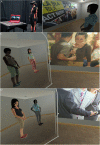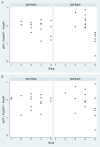Virtual race transformation reverses racial in-group bias
- PMID: 28437469
- PMCID: PMC5403166
- DOI: 10.1371/journal.pone.0174965
Virtual race transformation reverses racial in-group bias
Abstract
People generally show greater preference for members of their own racial group compared to racial out-group members. This type of 'in-group bias' is evident in mimicry behaviors. We tend to automatically mimic the behaviors of in-group members, and this behavior is associated with interpersonal sensitivity and empathy. However, mimicry is reduced when interacting with out-group members. Although race is considered an unchangeable trait, it is possible using embodiment in immersive virtual reality to engender the illusion in people of having a body of a different race. Previous research has used this technique to show that after a short period of embodiment of White people in a Black virtual body their implicit racial bias against Black people diminishes. Here we show that this technique powerfully enhances mimicry. We carried out an experiment with 32 White (Caucasian) female participants. Half were embodied in a White virtual body and the remainder in a Black virtual body. Each interacted in two different sessions with a White and a Black virtual character, in counterbalanced order. The results show that dyads with the same virtual body skin color expressed greater mimicry than those of different color. Importantly, this effect occurred depending on the virtual body's race, not participants' actual racial group. When embodied in a Black virtual body, White participants treat Black as their novel in-group and Whites become their novel out-group. This reversed in-group bias effect was obtained regardless of participants' level of implicit racial bias. We discuss the theoretical and practical implications of this surprising psychological phenomenon.
Conflict of interest statement
Figures





References
-
- Botvinick M, Cohen J. Rubber hands 'feel' touch that eyes see. Nature. 1998;391(6669):756–. doi: 10.1038/35784 - DOI - PubMed
-
- Blanke O, Slater M, Serino A. Behavioral, Neural, and Computational Principles of Bodily Self-Consciousness. Neuron. 2015;88(1):145–66. doi: 10.1016/j.neuron.2015.09.029 - DOI - PubMed
-
- Blanke O. Multisensory brain mechanisms of bodily self-consciousness. Nature Reviews Neuroscience. 2012;13:556–71. doi: 10.1038/nrn3292 - DOI - PubMed
-
- Ehrsson HH. The Concept of Body Ownership and Its Relation to Multisensory Integration In: Stein BE, editor. The New Handbook of Multisensory Processes. Cambridge, MA, USA: MIT Press; 2012. p. 775–92.
-
- Banakou D, Groten R, Slater M. Illusory ownership of a virtual child body causes overestimation of object sizes and implicit attitude changes. PNAS. 2013;110:12846–51. doi: 10.1073/pnas.1306779110 - DOI - PMC - PubMed
MeSH terms
LinkOut - more resources
Full Text Sources
Other Literature Sources
Medical

